Affiliate disclosure: This post may contain affiliate links. Please see our Privacy Policy.
Learn how to make a simple yet effective salve using jewelweed, an herb with powerful anti-itch properties that you might be surprised to find growing close to home.
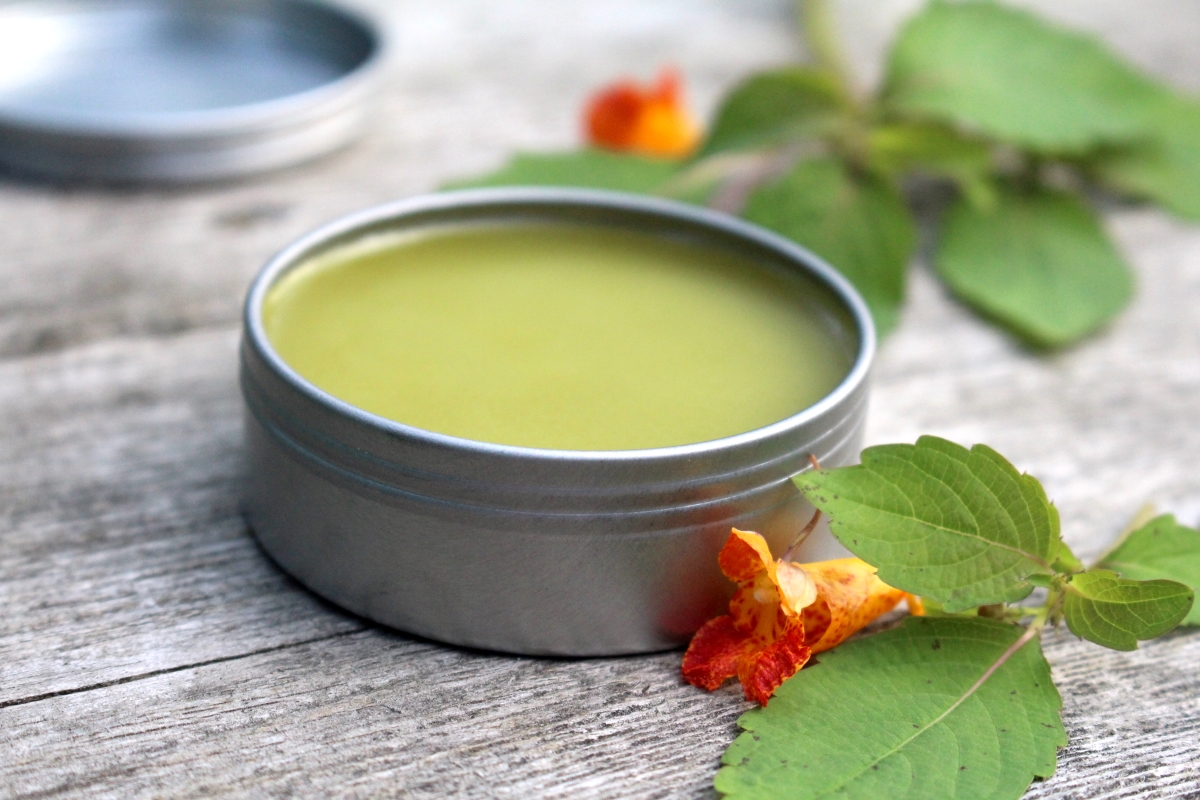
Jewelweed (Impatiens capensis), which also goes by the rather charming name of Spotted Touch-Me-Not, is hard to miss when it’s in bloom. With its striking red-speckled orange and yellow flowers, jewelweed is a natural draw to pollinators and foragers alike. (And it’s a special favorite of hummingbirds!)
What I love most about jewelweed, though, lies in its gorgeous green leaves, which have powerful anti-itch properties. These leaves are the base of this salve, which I always have on hand when we’re headed out for a hike or camping trip. Once you’ve tried this salve, you’ll be amazed at how effective it is at soothing itchy skin and tempering painful stings and other forms of external irritation.
If you’re just hoping to find a ready-made salve and skip the DIY portion, I’d suggest checking on Etsy for small-scale cottage industry producers since it’s not something that you’ll find in a store.
Looking for seeds to grow your own Jewelweed? You can get them from a small local seed company here in Vermont called Earthbeat Seeds.
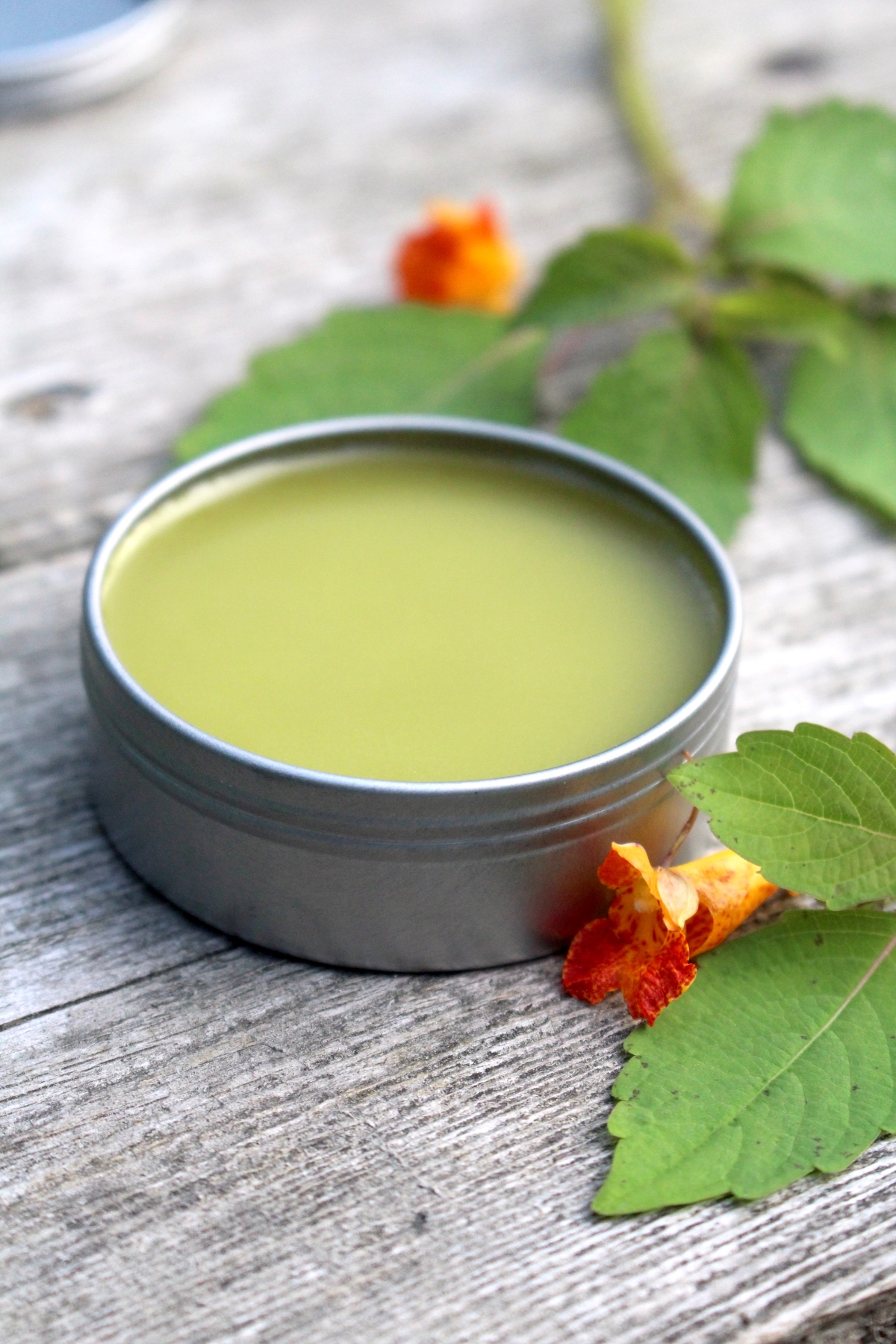
(Always consult your doctor or a clinical herbalist before trying any new herbal remedy, as there’s always the possibility of unintended consequences, allergic reaction, or interactions with other medication. If you’re harvesting wild plant material, make sure you’re 100% confident in your identification and consult multiple sources for your ID. The following is based on my research and experience, but I don’t claim to have any certifications that would qualify me to advise you on your health. Please do your own research and always verify with multiple reputable sources.)
What is Jewelweed?
Jewelweed is an herb that grows to a height of 3 to 5 feet tall. It has coarsely-toothed, oval-shaped leaves that are green on top and slightly paler underneath — the name “jewelweed” comes from the gathering of dew and rain on the plant’s leaves, which shimmers in the sunlight like a jewel.
Jewelweed grows plentifully all over the United States (with the exception of some of the more arid states in the southwest), and prefers moist areas with some degree of shade. A good place to start looking for jewelweed is along a nearby river or creek, especially in wooded areas.
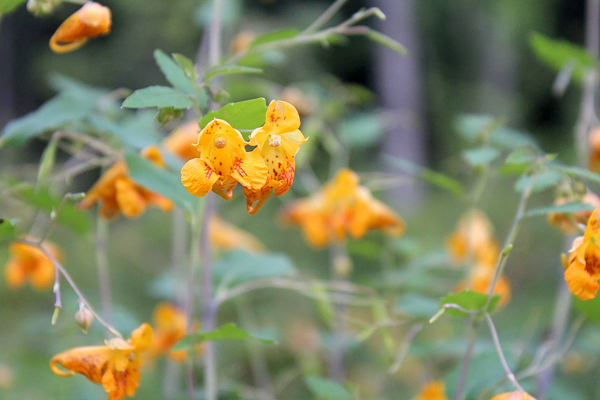
The flowers, leaves, and stems of the jewelweed plant can be used to calm itchy poison ivy blisters or to relieve residual pain from an encounter with stinging nettles as well as a number of other external ailments.
Besides being a medicinal plant, the entire plant is also edible. We enjoy the edible flowers in season, less for their taste and more for their bright color.
The seed pods, however, are absolutely delicious and taste like walnuts.
Benefits of Jewelweed Salve
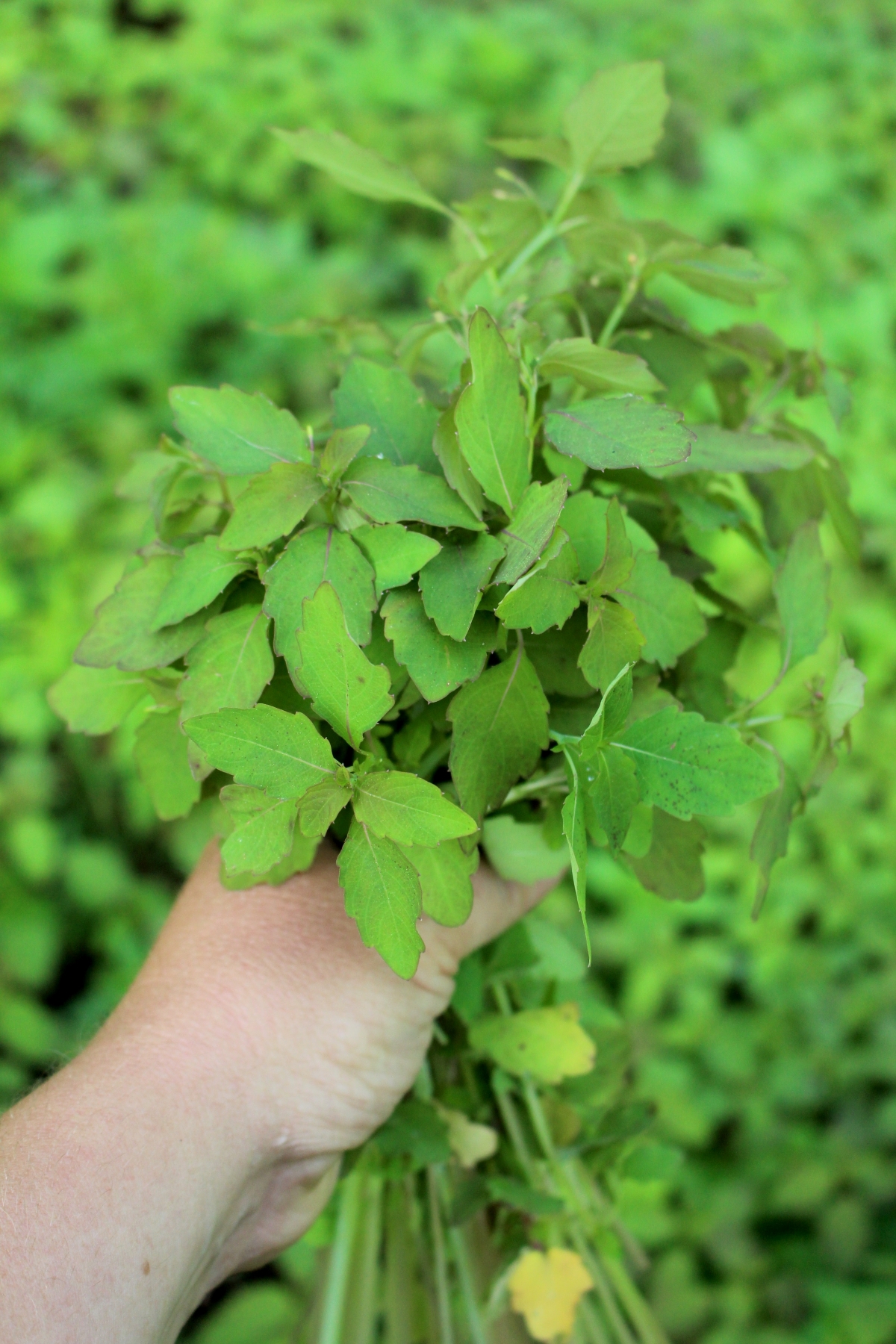
Supplies & Equipment for Making Jewelweed Salve
Making your own salve at home is easier than you might think. All you need are a few basic pieces of equipment (nothing fancy required!).
You’ll need a double boiler, like the ones found here, but it’s also super-easy to set up your own makeshift version using a heatproof bowl and a small pot, which is the method I use.
You’ll also need a neutral oil for infusing; olive oil is my go-to but you can also use almond, coconut, jojoba, or grapeseed oil. Each of these oils is soothing to the skin and they’re all easily sourced.
To thicken the salve and help it set, I use beeswax pellets because I find it’s less work to measure and you’re more likely to get an accurate measurement. You can also cut beeswax from a larger block if that’s what you prefer or have available.
If you don’t own one already, a small kitchen scale is an indispensable, inexpensive kitchen tool for measuring the beeswax (unless you happen to find beeswax in convenient 1 oz bars, like these).
And lastly, you’ll need some containers to store the finished salve. I like these 2-ounce salve tins because the screw top ensures the salve is kept free from dirt or dust (not to mention, they make lovely little gifts). If you like the look of glass, these quarter pint mason jars are also good options for storing your homemade jewelweed salve.
How to Make Jewelweed Salve
Making your own jewelweed salve takes only about 30 minutes of active prep time and the rest is almost entirely hands-off. I’m going to be showing you the warm rapid infusion method, which cuts the infusion time down from three to six weeks to only a couple of days. If making a salve is brand new to you, my guide to herbal healing salves is a great place to learn about the process as a whole.
The warm infusion method works best for fresh plant material as it eliminates the risk of the plant oils going rancid over a longer infusion process. If you’re interested in slow infusion, I’d recommend testing it out with dried plant material that isn’t as likely to spoil.
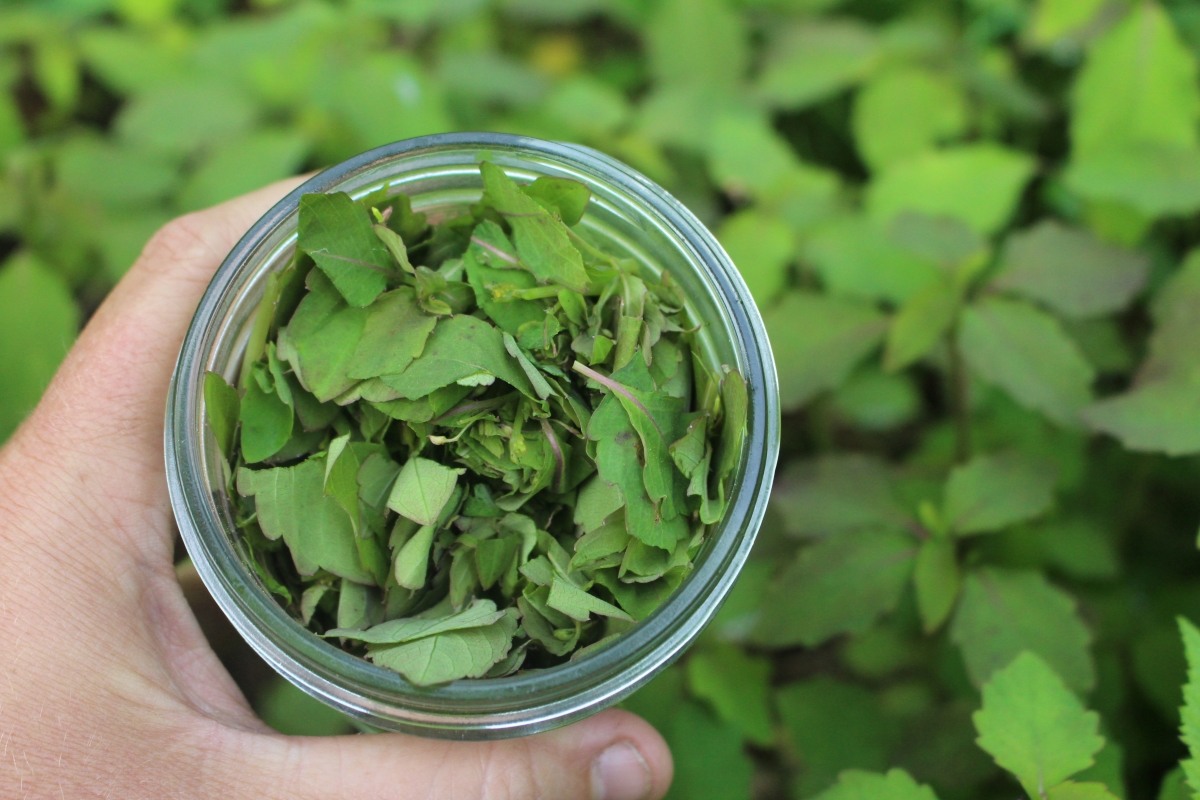
For this particular infusion, I’m going to use jewelweed leaves that have been freshly picked and then roughly chopped with gardening shears. You can see in these photos I’m more concerned with surface exposure rather than uniformity.
This salve is made from jewelweed leaves, but don’t worry if some stems find their way into the mix.
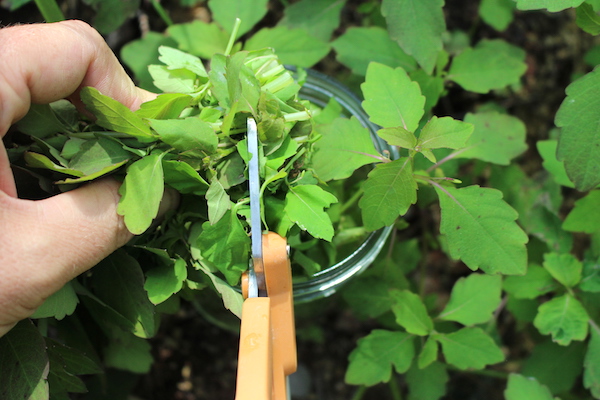
Fill a clean mason jar with the freshly chopped leaves, you want them to be packed down pretty firmly. I have jewelweed growing close by, so when I’m making this salve I usually bring the jar with me and cut the leaves directly from the plant, stuffing the jar as I go.
If I’m preparing multiple jars, I’ll bring the leaves back to the porch and stuff the jars there.
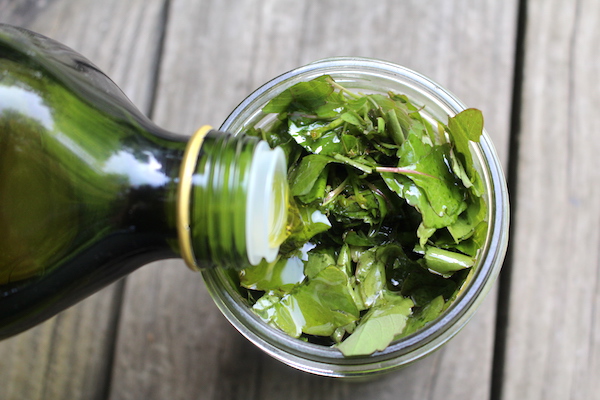
The next step is to cover the plant material with a neutral oil, whichever one you have chosen for the salve. I always have olive oil on hand since I cook with it regularly, but as I mentioned above you can use any oil that’s nourishing for the skin.
Prepare a double boiler by filling it with about an inch of water. Alternatively, you could make your own with a saucepan and heat-proof bowl, or you can even use a slow cooker. If you go with the slow cooker method, make sure you place the jar on a trivet. Again, you can DIY the trivet by using a mason jar lid or an old cotton dishtowel instead.
(Lacking a stove, there are other ways to make herbal infused oils, including a slow infusion method that uses dried herbal material.)
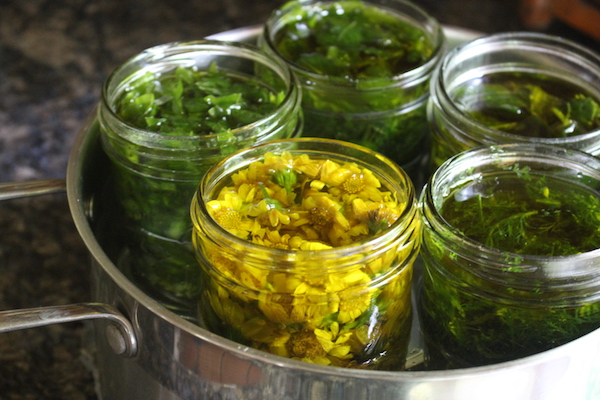
Gently heat the water in the double boiler to 110 to 120 degrees (the keyword is gently, you’re not looking to cook the herbs, just infuse the carrier oil with jewelweed). If the oil gets too hot, it will result in a finished salve that’s not as potent as it could be.
Keeping the water at a steady 110 to 120 degrees, infuse the jewelweed over the next 24 to 48 hours. To minimize the risk of too much heat (or not enough), I like to bring the water back up to temperature before turning it back off. Overnight, I’ll use this same strategy, but I’ll drape a towel over the pot to keep the infusion cozy. Monitor the water level over as the infusing is going on, adding more as needed.
When you feel like the jewelweed infusion is finished, it’s time to make the salve. Strain the jewelweed leaves out of the infused oil and pour it back into a heatproof bowl (or double boiler). Place the bowl over simmering water in a small pot, and add the beeswax. Keep stirring until the beeswax and oil are completely incorporated and the mixture is totally smooth.
For fairly accurate beeswax measurements without a kitchen scale, 1 ounce of solid beeswax is roughly the equivalent of 1 heaping tablespoon of beeswax pistils.
Carefully pour the salve into tins or jars and let it sit for at least 30 minutes before using. Use the salve within 1 year for best results (you can continue to use it after a year, it will just lose some of its potency).
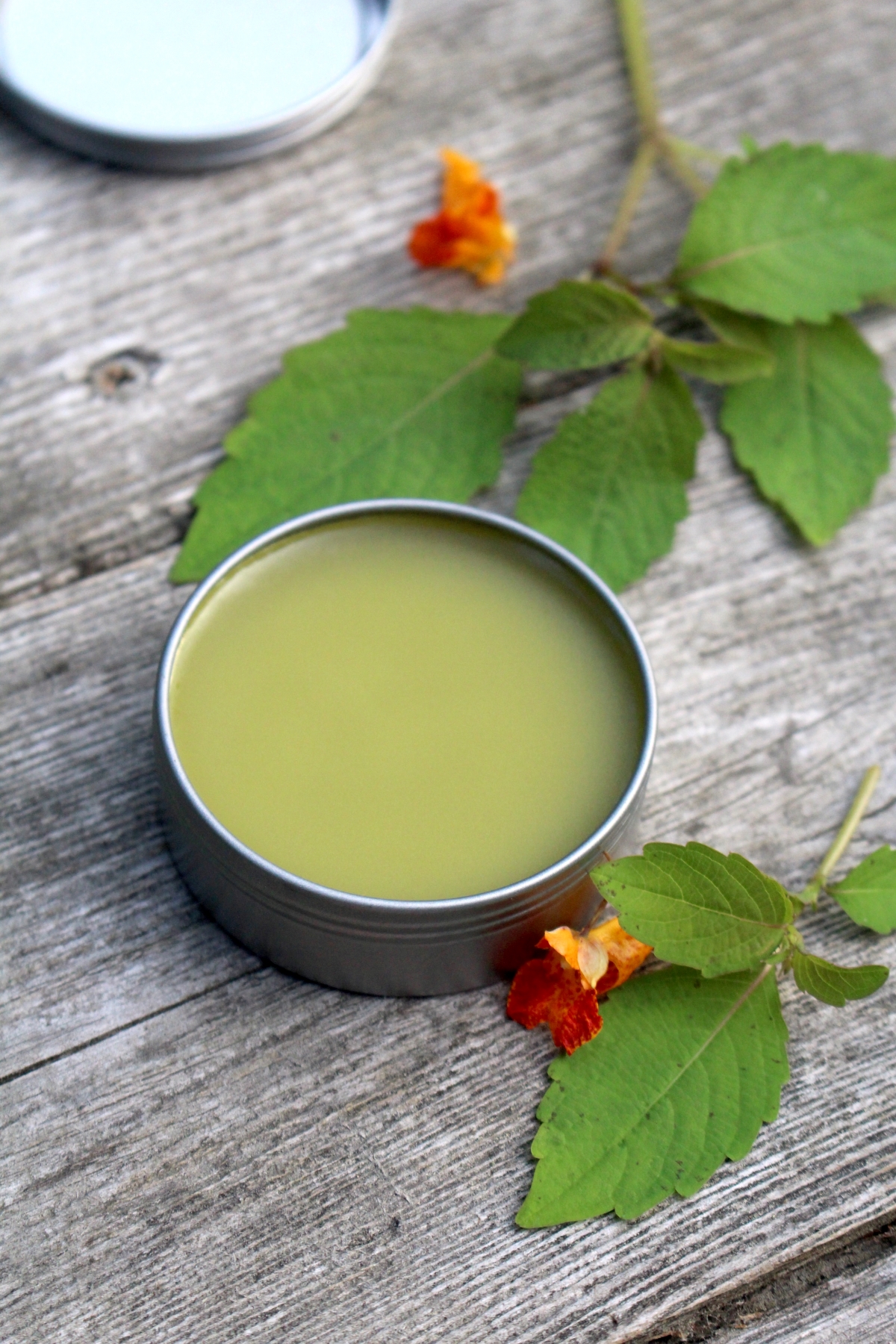
Other Ways to Use Jewelweed
Looking for other ways to use jewelweed?
- Jewelweed Soap for Poison Ivy from Simple Life Mom
- Jewelweed Tincture
- Jewelweed Ice Cubes from Sweet Song Herbals
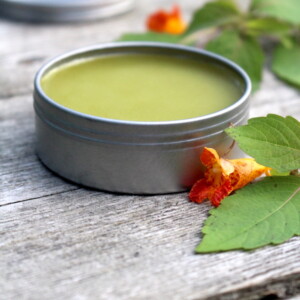
Jewelweed Salve
Equipment
Ingredients
Instructions
- Roughly chop the jewelweed leaves until you have enough to fill a mason jar almost to the top. Make sure the leaves are packed down.
- Cover the leaves with olive oil (or any neutral oil you've chosen).
- Fill a saucepan or slow cooker with 1 inch of water. Carefully place the jewelweed- and oil-filled jar on a trivet in a double boiler or in the slow cooker.
- Slowly heat the water until it reaches 110 to 120 degrees. Turn off the heat.
- Over the next 24 to 48 hours, infuse the oil over very low heat by bringing the water back up to temperature periodically over the next 24 to 48 hours. Don't leave the heat on for any prolonged amount of time and never allow the water line to get too low.
- Once the oil is infused to your liking, strain the jewelweed leaves from the oil.
- Pour the infused oil into a heatproof bowl (or double boiler) over simmering water.
- Carefully add the beeswax to the warm oil, stirring until smooth.
- Pour the finished salve into small tins or glass jars.
- Let the salve cool for at least 30 minutes before using.
Homemade Herbal Salve Recipes
Looking for more homemade herbal salve tutorials?
Disclaimer on Homemade Herbal Remedies
I’ve been foraging wild medicines and treating my family with herbal remedies for the past 20 years, but I’m self-taught. Be aware that I am not a clinical herbalist, and this is based on my own research and personal experience using medicinal plants. I do not claim to have the experience that’d qualify me to advise you on your health, and I’m only providing this as a reference to encourage a broader interest in medicinal plants.
Please use this as a jumping-off point, but always do your own research and verify anything you read with multiple sources.
It’s always possible to have an adverse reaction to any medicinal herb, and plenty of people are allergic to even gentle herbs like chamomile. Always consult your doctor or a certified herbalist before trying any new medicinal plant. Often, they can have unintended reactions in combination with other herbs and supplements, and many herbs have side effects even when they are effective for their intended purpose.
If you are seriously interested in herbal medicine, I’d suggest investing in a course in herbal medicine, and I’d recommend any of the online courses put out by the Herbal Academy of New England. Specifically, the introduction to herbal medicine course and the family herbalist group of courses.
They also have a mushroom course, covering both medicinal and edible mushrooms, and a Botany and Wildcrafting Course. I’ve taken both and they’re informative, inspiring, and artfully presented.
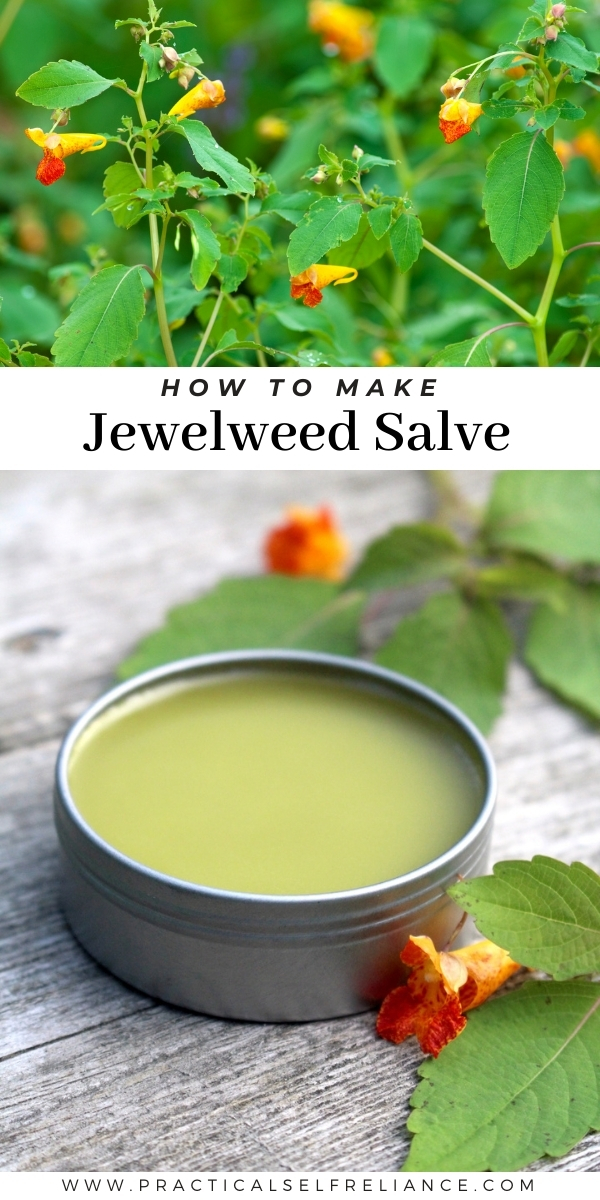


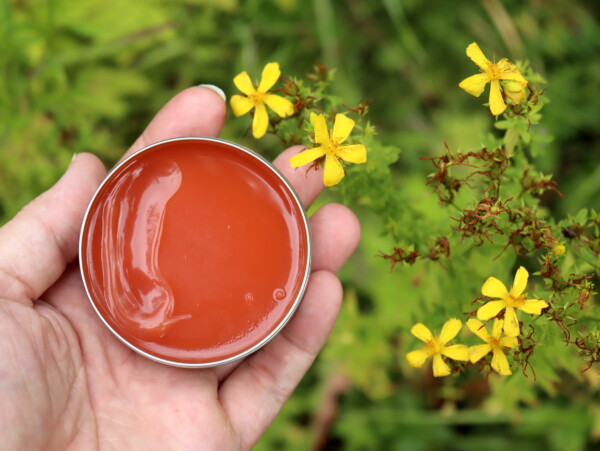
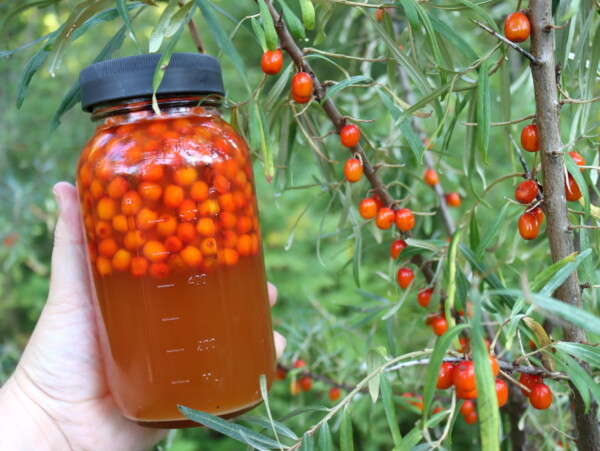
I made this salve previously and have had wonderful results. It’s time for another batch and I wanted to try the warm infusion method you recommended. Pawing through the pantry shelves I found a dusty yogurt maker I received as a gift so many years ago. Doing some research I found that the holding temperature for the unit is 115 F and I can run the device for 15 hours at a time. It appears the yogurt maker may get a new lease on life for this project, and any other warm infusion processes in the future. Maybe I’ll even make some yogurt.
Thanks.
Since writing this recipe I’ve also made this salve in my yogurt maker, as well as my excaliber dehydrator. They’re so good for keeping those temps!
Ashley, I am really wanting to make this salve and see how it works for us. Pardon the pun, but jewelweed grows like a week around our property.
I do have a couple of questions before I delve into this adventure. 1. Do you use just the green of the plant or include the blossoms as well? Do you buy commercially available beeswax that has been “cleaned up” or something directly from a beekeeper?
I use the whole plant and don’t really distinguish between the flowers and the leaves here, but doing so, it’s probably 98% leaves because they are so much more abundant on a plant. I generally use cleaned up bees wax because it gives a nice smooth salve, but you can use it straight from a beekeeper if that’s what you can get. (You can also get it from a beekeeper and strain it yourself.). Enjoy!
Are smal glass jars ok to use?
Yes, small glass jars work just fine. You don’t have to have metal tins.
Can coconut oil be used instead of bees wax to make it solid??
You could use coconut oil but it will be quite a bit softer than the salve with the beeswax.
Hello Ashley, I have a couple questions. First have you ever added essential oils to your salve? I’m reading in the comments that some have and it seems like a great idea. The thought had crossed my mind so I was thinking of trying it as well.
Also, have you ever used cocoa butter instead of or combined with beeswax? I have both actually, as we have bees, but I had ordered some cocoa butter wafers from Mountain Rose herbs for just such purposes but have not tried it yet. Just curious if you knew whether it would work as well as the beeswax or last as long.
I also noticed (just like Christina) that when I strained my infused oil into a jar it has a layer of orange liquid underneath the oil. I’m guessing it is just as you mentioned, the water content from the plant. I’m wondering if there’s a way to easily separate the 2 before melting my beeswax in? I have a feeling it won’t last as long if I don’t.
Yes, essential oils are great to use. Just be sure to look up the dilution rate so that you’re using a safe amount. The cocoa butter should be fine. It will be a little different consistency than what you typically expect from a salve but it will work or you could try doing part beeswax and part cocoa butter. As for the water, you can gently pour the oil off the top, leaving the watery sludge in the bottom.
I just made my first batch after coming across this recipe/technique; I have learned the very hard way that my new property has poison ivy *everywhere*. I used my mini crockpot as the heating source, opted for grapeseed oil as it is noncomedogenic, and am currently waiting on it to cool in the jars. I draped a towel over the crock to try to contain and preserve the heat in between On/Off periods; it only has Low and High, and both settings get too hot to leave it on consistently. I cycled the heat for ~40hrs, and once or twice it reached ~140°, but no higher.
I used cheesecloth to squeeze the oil out of the infusion/plant material mixture and let it run through a sieve before going into my bowl. Perhaps I got too aggressive or used too much pressure when squeezing because I did notice some red-orange/rust-colored liquid being extracted at the end of my squeezes.
I melted in the beeswax over a double boiler, and poured into two jars. It appeared smooth and well-homogenized prior to pouring. The smaller 2oz jar looks smooth, a creamy dusty olive in color, but the larger 8oz jar developed an obvious different layer immediately after pouring the remaining mixture. Again, I did notice this different color/substance as the pour finished, and it sank through the oil to settle at the bottom. I wish I could attach a photo here.
Can you offer any insight here? Could it be as simple as “don’t squeeze it so much”, or “don’t squeeze at all, just let it drain in a sieve”? Is it excess plant material that will just sit there as a bottom layer? If so, I suppose that jar’s contents is now compromised? (Meaning in the sense that it won’t last as long as the recommended 1 year timeframe.)
Yes, it is really that simple. Anytime you are using plant material that still has moisture in it, you want to avoid squeezing it. All of that moisture is being squeezed out of the plant material and right into your salve. You can still use the cheesecloth to catch any finer particles that might be missed by the sieve, just don’t squeeze it. I think I would remove the salve that isn’t discolored, leaving the discolored material. You can then heat it up and re-pour it. I think if you leave out the discolored material and reheat it then you should be ok.
My family and I have been trying jewelweed for different things. It is amazing. It is listed as an anti-inflammatory, anti-histamine, and anti-fungal. We have used it for toe fungus, arthritis pain and muscle cramps.
That’s wonderful. Thanks for sharing.
GJ Amber – You mentioned in your comment that your family has been trying jewelweed as an anti-inflammatory, anti-histamine and anti-fungal. Where did you find the info for these uses. We have jewelweed all over our property. I would like to give it a try for other uses to see how we can benefit from it.
I tried the crockpot method but I think the water bath got too hot for too long – up to 200 degrees for eight hours. Is it ruined? I can start again. Would a heating pad and a tea cozy work well enough? That’s what I use for yogurt making with good results.
If the heating pad and tea cozy works for the yogurt, it should work fine for the salve as well. As long as your herbs didn’t get burnt the crock pot one should be totally fine.
I’m just completing 4 new batches of jewelweed salve. I have several requests from family & friends. I could fit 4 quart jars in my crockpot. I’m getting this large batch made before the jewelweed is done for the season. I’ve had good success with this recipe. Thanks again! 🐝🐝 A local beekeeper friend gave me the beeswax so this batch is really locally sourced. 😊
You’re very welcome. So glad you enjoyed the recipe.
Hello! How much beeswax if you are doing three 12 oz mason jars? Currently trying to get mine to set! 🤣
This recipe makes 6 tins of salve that are each 2 oz. so the recipe makes 12 oz of salve total. If you want to fill three 12 oz jars then you would need to triple the recipe which would be 3 oz of beeswax.
I made my first batch of this using a small crockpot. Immediately, my daughter needed some. she said it smelled like Chinese food (???) so her dogs were very interested in licking her leg haha BUT it removed her itch like nothing else she had tried. I just ordered tins hoping that my current batch will make it into tins before being shared. We have jewelweed all over the place here. Who knew??
thanks so much for sharing this!
You’re very welcome. We are so glad you enjoyed the post. That’s interesting that she thought it smelled like Chinese food and that the dogs were so interested in it.
I added some rosemary essential oil to help improve the scent. I like it very much and use it often. It’s amazing stuff!!! 🐝🌿🌿🌿🌿
Can you use the described method with dried jewelweed? The wording is unclear to me.
Thanks!
The method described in this post is actually done with fresh plant material. You can dry jewelweed as you would any other plant. You can lay it out in a single layer to air dry or use a dehydrator. Many people think that it loses some of its potency when it is dried though and it is typically suggested to use the fresh plant preparation method.
Yesterday & today I jumped into this project. We have jewelweed everywhere on our property. I made two batches. One with olive oil and one with flaxseed oil. I experimented with adding some rosemary essential oils to the olive oil batch. It really came out beautifully. Does it have a slight earthy plant smell. Not really too appealing. Did I cook it too much or is that smell just how it is? The rosemary added a nice scent. Thanks for the recipe. I have dry skin and often feel itchy when I’m out working in the yard gardening etc. I plan on using this salve a lot. I’m ready to try more recipes like this! 🌻🦋
I’m wondering if, instead of a double boiler or bowl/pot set up, my Salton yogurt maker would work for this? It has five glass cups, which I have sometimes replaced with 8-oz Mason jars. I suppose the smaller jars would fit as well. And should I do this with or without lids?
I don’t see why it wouldn’t work. Let us know if you decide to give it a try.
I’m wondering if its possible to make the infusion w/ jars set into a slow cooker/crockpot? Also- how many 2 oz. tins does this recipe make? Finally – you’ve got a great site here- I like your straightforward approach and the idea that anyone can take on these projects. Thanks for being authentic.
A crockpot should work just fine. You should end up with six 2 oz. tins.
Did anyone use the crockpot method? Im going to try Wednesday!
Here, I have a more prolific crop of Himalayan Balsam. After much research, I found that the properties are similar enough to warrant me trying as a cream for poison ivy and stings. I have both salves and I think I like the Balsam better. It seems to work faster. Have you tried it?
I wasn’t familiar with them, I had to look it up actually, but now I’m going to keep an eye out for them to try it. Thank you!
Sorry I’vr taken so long to reply, if you are interested in some of the seeds, email me and we can exchange info. I am a couple of 3 weeks away from harvesting the seeds and will be happy to send you some if you’d like.
Instead of double boiler, I have an induction cooker. Would that work? And how? Just place jars in a pot with or without water?
An induction cooker should be fine. You would place the jars in a pot with water and I like to have something else on the bottom of the pan so that the jar doesn’t have direct contact with the bottom of the pan. You can use a rack of some kind, a canning ring or even a dish towel.
Good medicine to have on hand.
Thank you for this! Just a few days ago I was hoping to find some information on preserving the healing goodness of jewelweed. My husband just had a brush Poison Oak. I took the juiciest jewelweed stems I could find and ran them through the blender, and applied to the affected area. He said it didn’t really help with the itch (this was in the evening) but the next morning the rash was completely gone. I did not know the leaves could be used as well. I look forward to trying some of the flowers and seed pods (if the deer don’t eat them all!)
That’s wonderful! Thank you for sharing.
Lourdes- what a beautiful name ! Are you from NY ? I used to know a wonderful girl name “Lourdes “
How do I print your recipes ? I can not find any print buttons or shortcuts . Thanks
Each post that has a recipe should have a print button under the picture at the top of the recipe. Just scroll down towards the bottom of the page until you see the actual recipe.